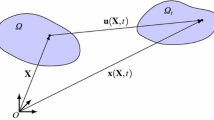Abstract
The nonlinear normal modes have recently been investigated with the method of strained coordinates for spring-mass models with some springs with piecewise linear stiffness. The N d.o.f. case and the mathematical validity of the method for large time were rigorously proved. The time validity is related to the nature of contact. For grazing contact, this method and also the multiscale expansion lose nonlinear features. For a small piecewise linear stiffness, we show that this method is less precise for a weak unilateral grazing contact. Thus, the validity of the asymptotic expansion for large time cannot be improved and the method has to be modified.








Similar content being viewed by others
References
Jiang, D., Pierre, C., Shaw, S.W.: Large-amplitude non-linear normal mode of piecewise linear systems. J. Sound Vib. 272, 869–891 (2004)
Kerschen, G., Peeters, M., Golinval, J.C., Vakakis, A.F.: Nonlinear normal modes, part i: a useful framework for the structural dynamics. Mech. Syst. Signal Process. 23, 170–194 (2009)
Vestroni, F., Luongo, A., Paolone, A.: A perturbation method for evaluating nonlinear normal modes of a piecewise linear two-degrees-of-freedom system. Nonlinear Dyn. 54(4), 379–393 (2008)
Junca, S., Rousselet, B.: The method of strained coordinates for vibrations with weak unilateral springs. IMA J. Appl. Math. 76(2), 251–276 (2010)
Kevorkian, J., Cole, J.D.: Perturbation Methods in Applied Mathematics. Applied Mathematical Sciences, vol. 34. Springer, Berlin (1981)
Kevorkian, J., Cole, J.D.: Multiple Scale and Singular Perturbations Problems. Applied Mathematical Sciences, vol. 114. Springer, Berlin (1996)
Miller, P.D.: Applied Asymptotic Analysis, vol. 75. American Mathematical Society, Providence, Rhode Island (1996)
Junca, S., Rousselet, B.: Asymptotic expansions of vibrations with small unilateral contact. Proc. Phys. 128, 173–182 (2009)
Luongo, A., Zulli, D.: A paradigmatic system to study the transition from zero/hopf to double-zero/hopf bifurcation. Nonlinear Dyn. 70(1), 111–124 (2012)
Bastien, J., Bernardin, F., Lamarque, C.-H.: Non-smooth Deterministic or Stochastic Discrete Dynamical Systems [Applications to Models with Friction or Impacts]. Mechanical Engineering and Solid Mechanics Series. Wiley, New York (2013)
Nayfeh, A.H.: Perturbation Methods. Pure and Applied Mathematics. Wiley, New York (1973)
Acknowledgments
We thank Claude-Henri Lamarque, Mathias Legrand and Bernard Rousselet for fruitful discussions on nonlinear normal modes.
Author information
Authors and Affiliations
Corresponding author
Appendices
Appendix 1
In this appendix, we compute the following exact expression for the period with the energy.
\(T(\varepsilon )\) To obtain this period formula, i.e., Formula (11) before, we use the well-known relation between the energy and the period [7]. Using the symmetry with respect to the horizontal axis in the phase space, we compute the half period:
Formula (28) comes from the relation \(\dot{u}\,\,{=}\,\,{\pm } \sqrt{E- F(u)} \). For the half superior part: \(\dot{u} > 0\) and since \(E=E_0\), the relation becomes: \( \frac{\hbox {d}u }{\hbox {d}t} =\sqrt{E_0 - F(u)}\), so \(\mathrm{d}t = \frac{\hbox {d}u}{\sqrt{E_0 - F(u)}}\) which yields relation (28).
Since \(F(u)\) has different expression for \( u<1\) or \(u>1\), we decompose the integral in (28) in two parts. The computation is explicit with the function \(\arcsin \) and the following relations for \(A>0\):
Equality (30) means the left-hand side is an antiderivative of the right-hand side. We also recall the \(\arccos \) function for \( y \in [0,1]\):
Now, we can compute \(T/2\):
Notice that \(u_- = - \sqrt{E_0}\) so:
We now turn to \(T_0\) with the notation \(u=1+v\) and \(\eta = 1/(1+\varepsilon )\):
from (30) and
Adding \(T_{-}\) and \(T_{0}\) we obtain \(T/2\) and then (11).
Appendix 2
We compute (26): the asymptotic expansion of the period \(T(\varepsilon )\) from the exact expression of the period (11).
The details of the computations first use an expansion of the function \(\arccos (y)\) near \(y=1\).
We now prove this formula. First, by (31), we have the following:
We now have an integral with the parameter \(h\) which is not singular. Thus, \(g\) is a smooth function and we have the following expansion with fractional powers of \(h\):
We compute \(g(0), \, g'(0)\) and \(g''(0)\) to get formula (32).
We now turn to asymptotic expansion of the exact period \(T(\varepsilon )\). For this purpose, we compute the expansions of the two last terms defining the exact period \(T(\varepsilon ) = 2\, \pi + T_2 + T_3\) defined by (11):
To expand \(T_2\) with respect to \(\varepsilon \), we notice that from (28), (25):
Let \(h\) be defined as:
We now can compute \(T_2\):
For the third term, we have
Now we expand \(h, \, h^{1.5}\) and \(h^{2.5}\):
These yield to the expansion of \(T_3\):
Finally, adding the expansions for \(T_2\) and \(T_3\), we obtain
and then (26).
Appendix 3
We compute the exact solution to compare it numerically with some asymptotic expansions. Since the ODE (7) is piecewise linear, we have after some computations:
where \(u_-\) and \(\eta \) are defined in Sect. 3, \(T=T(\varepsilon ) \) and
Rights and permissions
About this article
Cite this article
Junca, S., Tong, L. Limitation on the method of strained coordinates for vibrations with weak grazing unilateral contact. Nonlinear Dyn 80, 197–207 (2015). https://doi.org/10.1007/s11071-014-1860-9
Received:
Accepted:
Published:
Issue Date:
DOI: https://doi.org/10.1007/s11071-014-1860-9




